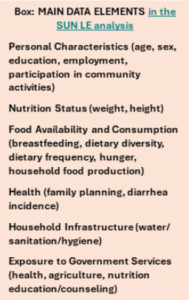Written by Mary Pat Selvaggio, Mathews Onyango, and Patricia Sakala
Khulisa’s Scaling Up Nutrition Learning and Evaluation (SUN LE) project recently completed a large, population-based survey of Zambia’s nutrition program that used both Qualitative Comparative Analysis (QCA) and Regression Analysis methods to explain relationships between various nutrition-related variables and the prevalence of stunting (a program outcome) in young children.
QCA, which is used for analyzing qualitative and categorical data and exploring non-linear and interactive relationships among variables, is a powerful tool for identifying combinations of conditions that contribute to an outcome. QCA operates without the assumption of linearity or independence of variables, and is best used for smaller sample sizes, where precision may be sacrificed for a more nuanced understanding.
Conversely, regression analysis deals with quantitative data, mainly focusing on the linear relationships between variables. Its advantage lies in estimating the strength and direction of associations, assuming a linear relationship and relying on larger datasets for more precise estimates.
The midline survey included 7,500 households, and collected on both mothers and children around a wide range of personal and household characteristics and behaviors (see box).
Using multiple regression analysis, we examined mother/child/household characteristics that are most strongly related to poor child growth (stunting).
This analysis identified several factors that are associated with higher likelihood of stunting – namely young mother age (i.e., teenage mother), child age over 18 months, male child, and the head of household not being engaged in any economic activities. On the other hand, the analysis showed that the likelihood of stunting was lower among children whose mothers used family planning, and those whose mothers were more educated.

The value of the regression analysis in this survey was in helping program implementers to better identify individuals and households at risk of poor child growth based on the key factors listed above.
Using QCA, we examined the association between poor child growth (stunting) to the performance of nutrition interventions at the district level. We assigned district-level scores (“1” or “0”) for the major interventions that the program intended to deliver to households. When there was an improvement in the proportion of households exposed to the intervention as compared to baseline, the district scored “1”. When there was a lack of improvement in the proportion of households exposed to the intervention as compared to the baseline survey, the district scored “0”. We also scored the change in a district’s stunting prevalence from baseline, coding the district as “1” if there was an improvement and “0” if there was no decrease in child stunting in the district.
QCA analysis then allowed us to determine the combination of services associated with improved child growth. The analysis showed that reduced stunting was associated with an expansion of at least four of five key interventions: 1) minimum diet diversity for women; 2) minimum meal frequency; 3) child diet diversity; 4) access to basic water; and 5) access to basic sanitation. If a district had improved in only three or fewer interventions, there was no observed improvement in the stunting outcome.
The value of the QCA analysis in this survey was in identifying the minimum combination of interventions or services required for improving the desired outcome (reduced stunting), thereby helping program managers to prioritize delivery of interventions in the target districts.
Both analytical methods bring advantages to a program, and the combination of the two was important to guide program managers on which interventions to focus on in general (QCA) and then who should be an important target for service provision (regression).
QCA thrives in smaller to medium-sized samples and is ideal when the goal is to identify necessary and/or sufficient conditions for an outcome. In contrast, regression analysis is well-suited for larger samples and when researchers aim to quantify the magnitude and direction of relationships.
In conclusion, the nuanced insights and intuitive presentation of QCA results, along with the precision and focus of regression analysis, provided Zambia’s nutrition program with valuable insights into “what” and “who” to focus on when addressing child undernutrition.


